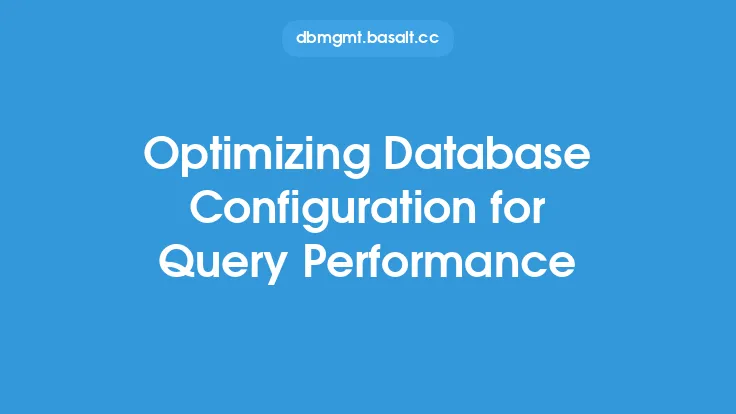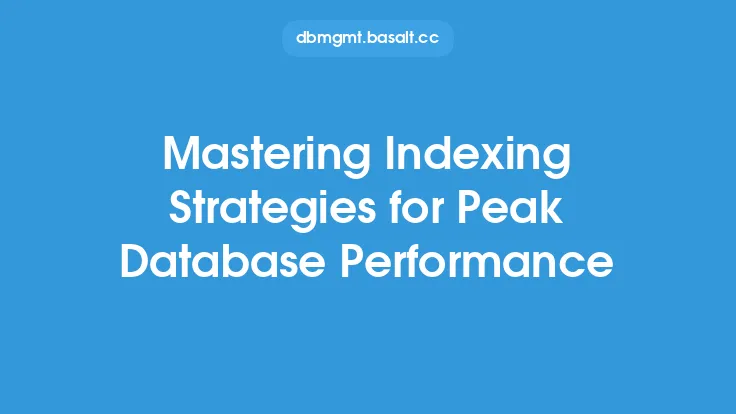When it comes to ensuring the optimal performance of a database, testing plays a crucial role. Database testing involves evaluating the database's functionality, scalability, and reliability to identify potential issues and optimize its performance. In this article, we will delve into the various database testing strategies that can help achieve optimal performance.
Introduction to Database Testing Strategies
Database testing strategies are designed to test the database's functionality, performance, and security. These strategies involve a combination of manual and automated testing techniques to identify potential issues and optimize the database's performance. The goal of database testing is to ensure that the database is reliable, scalable, and secure, and that it meets the required performance standards. There are several database testing strategies that can be employed, including black box testing, white box testing, and gray box testing. Each of these strategies has its own advantages and disadvantages, and the choice of strategy depends on the specific requirements of the database.
Types of Database Testing
There are several types of database testing, including functional testing, performance testing, security testing, and scalability testing. Functional testing involves testing the database's functionality to ensure that it meets the required specifications. This includes testing the database's queries, stored procedures, and triggers. Performance testing involves testing the database's performance to ensure that it meets the required performance standards. This includes testing the database's response time, throughput, and concurrency. Security testing involves testing the database's security to ensure that it is secure and protected against unauthorized access. Scalability testing involves testing the database's scalability to ensure that it can handle increased traffic and data volume.
Database Testing Techniques
There are several database testing techniques that can be employed, including equivalence partitioning, boundary value analysis, and state transition testing. Equivalence partitioning involves dividing the input data into partitions and testing each partition to ensure that the database behaves as expected. Boundary value analysis involves testing the database's behavior at the boundaries of the input data. State transition testing involves testing the database's behavior as it transitions from one state to another. These techniques can be used to test the database's functionality, performance, and security.
Database Testing Tools and Technologies
There are several database testing tools and technologies available, including database testing frameworks, automated testing tools, and performance monitoring tools. Database testing frameworks provide a structured approach to database testing, allowing testers to create and execute test cases. Automated testing tools allow testers to automate the testing process, reducing the time and effort required to test the database. Performance monitoring tools allow testers to monitor the database's performance in real-time, identifying potential issues and optimizing the database's performance.
Best Practices for Database Testing
There are several best practices for database testing, including testing early and often, using automated testing tools, and testing for performance and security. Testing early and often involves testing the database as soon as possible, identifying potential issues and optimizing the database's performance. Using automated testing tools involves automating the testing process, reducing the time and effort required to test the database. Testing for performance and security involves testing the database's performance and security to ensure that it meets the required standards.
Challenges and Limitations of Database Testing
There are several challenges and limitations of database testing, including the complexity of the database, the lack of testing tools and technologies, and the limited time and resources available for testing. The complexity of the database can make it difficult to test, requiring specialized skills and knowledge. The lack of testing tools and technologies can limit the effectiveness of database testing, making it difficult to identify potential issues and optimize the database's performance. The limited time and resources available for testing can also limit the effectiveness of database testing, requiring testers to prioritize testing activities and focus on the most critical aspects of the database.
Future of Database Testing
The future of database testing is likely to involve the use of artificial intelligence and machine learning algorithms to automate the testing process. These algorithms can be used to identify potential issues and optimize the database's performance, reducing the time and effort required to test the database. The use of cloud-based testing tools and technologies is also likely to become more prevalent, allowing testers to test the database in a scalable and flexible environment. Additionally, the use of containerization and orchestration tools is likely to become more prevalent, allowing testers to test the database in a consistent and reliable environment.
Conclusion
In conclusion, database testing is a critical aspect of ensuring the optimal performance of a database. There are several database testing strategies, techniques, and tools available, each with its own advantages and disadvantages. By understanding the different types of database testing, database testing techniques, and database testing tools and technologies, testers can develop a comprehensive testing plan that ensures the database meets the required performance standards. Additionally, by following best practices for database testing and staying up-to-date with the latest trends and technologies, testers can optimize the database's performance and ensure that it is reliable, scalable, and secure.





